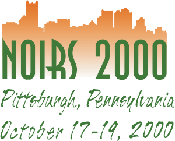 |
NOTE: This document is provided for historical purposes only.

The National Institute for Occupational Safety and Health (NIOSH), in
association with its public and private sector partners, hosted the second
National Occupational Injury Research Symposium (NOIRS) on October
17-19, 2000 in Pittsburgh, Pennsylvania.
NOIRS 2000 was a means of implementing the National
Occupational Research Agenda (NORA) for traumatic occupational injuries.
NORA was formulated through the cooperative efforts of business, labor,
academic, safety and health, and government leaders under the sponsorship
of NIOSH.
This symposium served numerous objectives aimed at preventing traumatic
occupational injury through research and prevention. They included:
- Presenting current research findings.
- Fostering collaboration among researchers from a broad range of disciplines
and perspectives, and exploring underutilized disciplines and topic areas.
- Identifying some best practices in the area of intervention.
- Exploring the cost-effectiveness of injury prevention strategies and interventions.
- Showcasing innovative and high technology approaches to research and prevention.
- Continuing to promote the implementation of the National Occupational Research
Agenda (NORA).
- Providing a forum for the reporting and fostering research needs identified
in the NORA report, Traumatic
Occupational Injuries: Research Needs and Priorities.
Questions addressed at the symposium included:
- What are the latest traumatic occupational injury research findings?
- What are emerging problem areas in workplace trauma?
- How is technology being applied to occupational injury research and prevention?
- What activities are being done to implement the National Occupational Research
Agenda (NORA) in the area of traumatic occupational injury?
- What are the best practice intervention and prevention strategies and which
strategies do not work? In what specific workplaces and under what
circumstances?
- What are the economic costs of traumatic occupational injuries and how
cost-effective are the prevention strategies?
- What are current and emerging research areas and disciplines?
- What are the trends in traumatic occupational injury and fatality incidence? In research tools, techniques, and methods? In
prevention?
- What specific workplace risks are faced by adolescents, older adults, minority workers, non-English-speaking workers,
low-literacy workers, and other special populations?
- How can researchers and practitioners in different sectors and disciplines better collaborate and coordinate their
activities to reduce traumatic occupational injuries?
- What methods are available to assess, quantify, and compare traumatic occupational
injury risks?
Occupational injury researchers from all disciplines attended and shared their research.
Participants included:
- Safety researchers
- Safety practitioners
- Health care professionals
- Administrators
- Epidemiologists
- Engineers
- Manufacturers
- Communication Researchers
- Health and science communicators
|
- Regulators
- Employers
- Policy makers
- Insurers
- Students
- Advocates
- Workers
- Educators and trainers
- Others interested in attending
|
The symposium consisted of contributed oral presentations in concurrent sessions, organized sessions around topics of
special interest, and poster sessions. Opening and closing plenary sessions featured invited speakers who
are among the leaders in the fields of public health, safety science, and injury research and prevention.
Page last modified: June 6, 2007
Page last reviewed: June 6, 2007
(archived document)
Content Source: National Institute for Occupational Safety and Health (NIOSH)
|
|
|

